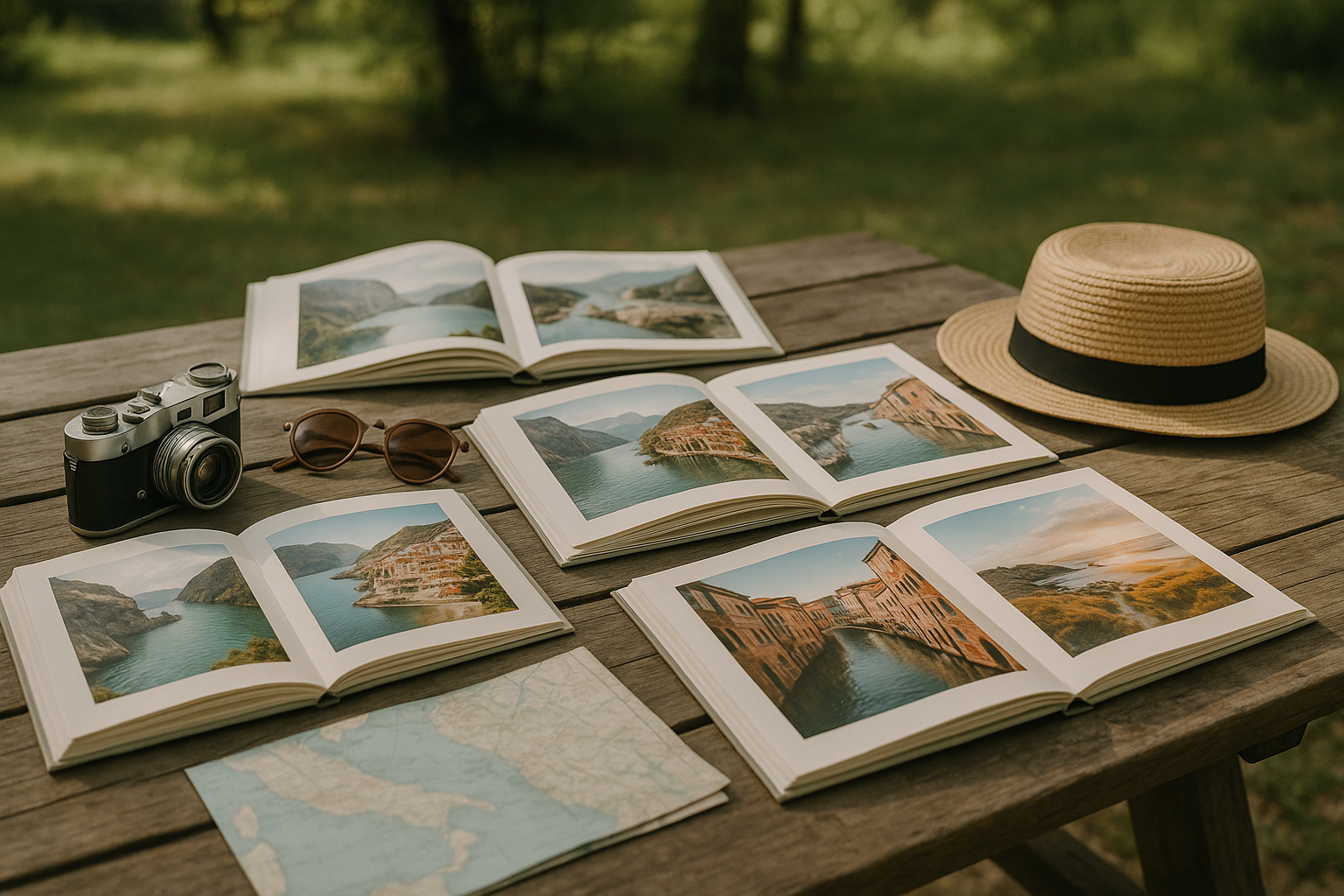It’s not just about visiting new places, it’s about the stories we live, the cultures we encounter, and the memories we make. There’s a raw emotion attached to travel, a feeling of wanderlust that leaves us yearning for more. But, how do you immortalize these moments? One of the best ways is to create a travel photo album. Not just any photo album, but one that captures the essence of your journey with clean aesthetics and artistic appeal.
But creating such an album is not as easy as it sounds. It requires a strategic approach, an understanding of design principles, and the right selection of photographs. This article is going to serve as a comprehensive guide for crafting a stunning travel photo album. It will cover everything from selecting the perfect pictures, arranging them for maximum impact, to adding finishing touches that enhance the aesthetics.
Travel photo albums are more than just collections of photos. They are tangible manifestations of your experiences, reflections of your emotions and personal tastes. Creating one requires a thoughtful approach, an understanding of how elements work together to create a cohesive narrative. This guide will help you navigate the process with ease, transforming your assortment of photos into a beautifully crafted narrative that embodies your wanderlust.
Our journey will commence with the importance of selection. Not all photographs make it to the album. Some are left behind while others take center stage. The trick is to understand which photographs have the potential to narrate your story effectively. We will delve deep into the process of selecting photographs, discussing the importance of aspects like composition, subject matter, and emotional impact.
The Art of Sequencing
Once we have a pool of photographs, the next step is arranging them in a sequence that tells a compelling story. The right sequence can elevate your album, transforming it into a visual journey that takes the viewer through your experiences. This section will uncover the art of sequencing, providing tips on how to create flow and rhythm in your album.
The Power of Design
Design plays a crucial role in enhancing the aesthetics of your album. It’s not just about how the photographs are arranged, but also about elements like typography, color schemes, and white space. Here, we’ll discuss how to use these design elements to create a clean, aesthetic appeal.
Lastly, we’ll talk about the finishing touches, the little details that add a layer of sophistication to your album. Whether it’s adding captions, choosing the right paper quality, or deciding on the album cover, every decision matters.
Travel is an enriching experience that broadens our horizons, challenges our perceptions, and feeds our souls. Creating a travel photo album is a way of preserving these experiences, giving them a physical form that can be revisited time and again. But the process of creating such an album requires careful thought and planning. This guide will equip you with the knowledge and tips you need to create an album that not only captures your journey but also resonates with the viewer. So, let’s embark on this journey together, and transform your travel photographs into a stunning narrative of your wanderlust.
Unlocking the Art of Travel Photography
Traveling offers a feast for the senses and a wealth of experiences that demand to be captured. But how can you encapsulate the majesty of a mountain range, the charm of an old town, or the vibrancy of a bustling market into a single image? The answer lies in understanding the art of travel photography.
Travel photography isn’t just about snapping a photo of a landmark. It’s about capturing the essence of a place: its people, culture, and atmosphere. It’s about telling a story. This requires not only technical know-how but also a creative eye and a deep appreciation of your surroundings.
Creating a stunning travel photo album involves careful planning, clever composition, and, crucially, an understanding of what makes a photo aesthetically appealing. In the next sections, we will delve into these aspects in detail, offering tips and insights to help you create a travel photo album that captures the spirit of your journey and mesmerizes your viewers.
Planning Your Travel Photography: Research and Reconnaissance
Before you set off on your journey, spend some time planning your photography. Research the locations you’re visiting: Look at photos others have taken there, study maps, and read about the local culture and customs. This can provide inspiration and help you identify potential photo opportunities. Moreover, understanding the local culture can help you approach people and situations with respect, allowing you to capture authentic moments.
One valuable tool for planning your travel photography is Google Earth. It allows you to virtually explore your destination, giving you a sense of the landscape and helping you identify potential vantage points. For example, if you’re visiting a city, you can use Google Earth to find rooftops, bridges, or hills that offer panoramic views.
Besides researching online, try to spend some time exploring your location once you arrive. This on-ground reconnaissance can reveal hidden gems that aren’t mentioned in guidebooks or online articles. It also gives you a chance to observe the light at different times of the day, helping you plan your shoots accordingly.
Composition and Aesthetic Appeal: Framing Your Shots
Composition refers to the arrangement of elements in a photo. A well-composed photo is balanced, engaging, and directs the viewer’s eye to the most important elements. Here are some composition techniques you can use to enhance your travel photos:
- Rule of Thirds: Imagine your photo divided into nine equal parts by two horizontal lines and two vertical lines. The rule of thirds suggests that you should place your subject along these lines or at their intersections. This creates more interest and balance than simply centering your subject.
- Leading Lines: Lines can guide the viewer’s eye towards the main subject or into the distance. Roads, rivers, and fences can serve as leading lines.
- Frame within a Frame: Framing your subject within a natural frame (such as a doorway or an arch) can add depth and context to your photo.
Besides composition, consider the aesthetic appeal of your photos. Aim for clean, uncluttered images with a strong focal point. Use color and light creatively to evoke mood and atmosphere. And remember, sometimes less is more: A simple yet striking image can be more powerful than a busy, complicated one.
For a visual guide to composition techniques, watch the video “Composition Techniques for Stunning Photos” by the YouTube channel “Photography Pro”. This video offers practical tips and examples to help you improve your composition skills.
Capturing the Essence: Going Beyond Landmarks
While landmarks are an important part of travel photography, they shouldn’t be your only focus. To truly capture the essence of a place, you need to look beyond the obvious.
Take photos of daily life: markets, street food, local people going about their day. These images can offer a glimpse into the local culture, making your photo album more interesting and authentic.
Also, consider photographing the less glamorous aspects of your trip. Long bus rides, crowded airports, or a rainy day can make for compelling images that tell a story. Remember, travel photography isn’t just about showing the highlights of your trip, but also the journey itself.
The Finishing Touches: Editing and Organizing Your Photos
Once you’ve taken your photos, it’s time to edit and organize them. Editing can enhance your images, bringing out the best in them. Use editing software like Adobe Lightroom or Photoshop to adjust the exposure, contrast, and colors of your photos. You can also crop your photos to improve their composition or remove distracting elements.
When organizing your photos, consider the narrative of your journey. Arrange your photos in a way that tells a story, moving from one location or event to the next. This can make your photo album more engaging and immersive.
Creating a stunning travel photo album is an art, requiring not only technical skills but also a keen eye for detail and a deep appreciation of your surroundings. But with careful planning, thoughtful composition, and a willingness to look beyond the obvious, you can create a photo album that truly captures the spirit of your journey.
Final Thoughts
Creating a stunning travel photo album isn’t just about taking beautiful photos. It’s about capturing the essence of your journey, telling a story, and evoking emotion. It’s about creating a visual diary that you can look back on and remember not just what you saw, but how you felt. So as you embark on your next adventure, remember to pack not just your camera, but also your curiosity, your creativity, and your sense of wonder.

Conclusion
In conclusion, the path to software engineering and the various concepts that govern this field are multi-faceted, presenting both a rewarding challenge and an opportunity for continual learning and advancement. As we have navigated through the primary aspects in this piece, it’s essential to grasp the concept that each topic covered forms an interconnected web of information, crucial for every software engineer.
Let’s briefly recap our journey.
We started by demystifying the concept of software engineering, looking at its various definitions and the scope of its application. From Link 1, we learnt that software engineering involves the design, development, and maintenance of software systems. The successful implementation of these steps is what results in the software applications that we use daily.
We delved into the importance of problem-solving skills and the crucial role it plays in this field. Whether in code debugging, designing new software, or improving existing systems, a software engineer must be adept at identifying problems and crafting effective solutions.
We then transitioned into the vital skill of programming. Here, Link 2 was a useful resource, highlighting that programming languages are the primary tools used by software engineers to communicate with computers. Understanding and mastering multiple programming languages, therefore, becomes a non-negotiable skill for any software engineer.
Thereafter, we discussed the importance of version control systems, as well as the role they play in managing and tracking changes in code. This aspect ensures the smooth functioning of any software project, especially in collaborative environments.
Lastly, we ventured into the world of algorithms and data structures, underlining their importance in organizing data and solving computational problems.
In this digital era, the importance of the subject matter covered in this piece cannot be understated. Software engineering is the driving force behind the various technological advancements we see today. It is, therefore, crucial for any aspiring software engineer to understand these concepts and continually improve their skills in these areas.
As we close this chapter, we invite you to continue on this path of learning. Share your insights, thoughts, or questions in the comment section below. Engage in conversations, broaden your horizons, and contribute to the growth of the software engineering community.
Remember, knowledge is an ever-evolving sphere. The more you explore, the more you understand, and the more proficient you become. As always, your dedication and passion for the field will significantly impact your journey’s success.
So, go ahead! Dive into the world of software engineering. Each line of code written, each bug resolved, and every new concept grasped brings you one step closer to becoming a competent and successful software engineer.
Keep exploring, keep learning!
Source: Link 3, Link 4 and Link 5.



